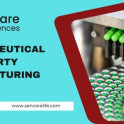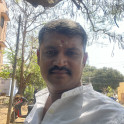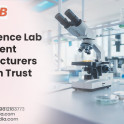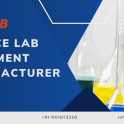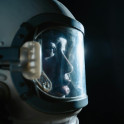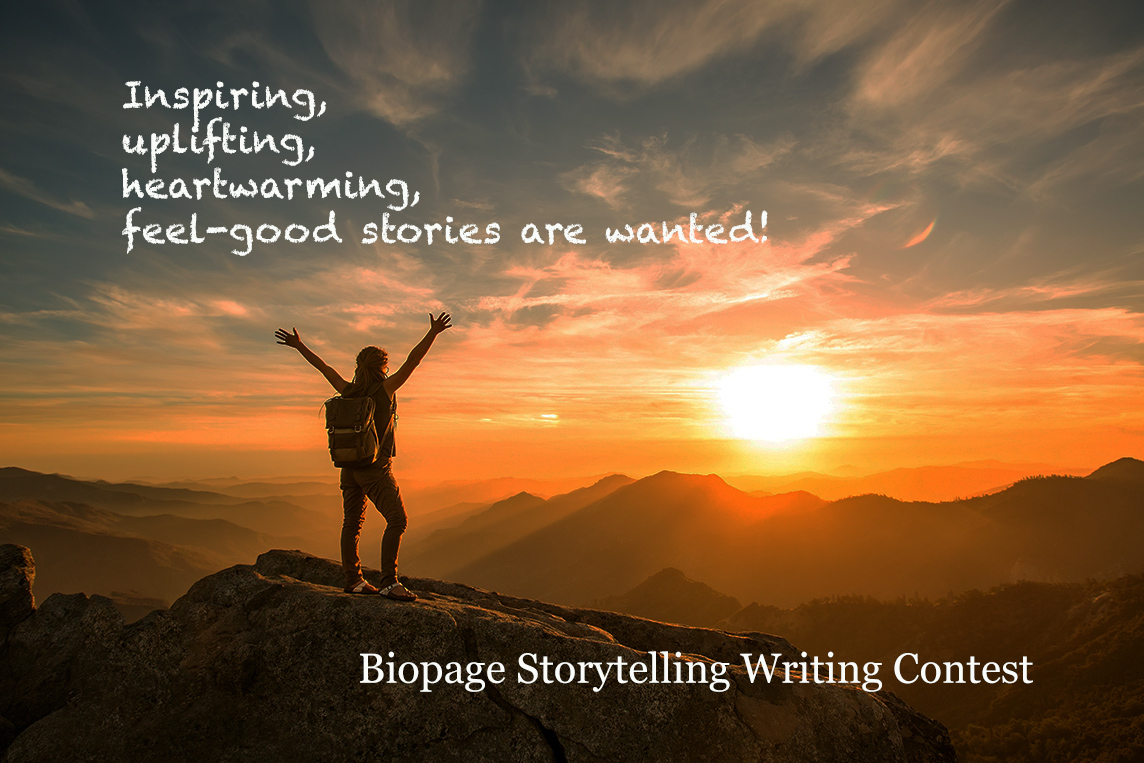There are many pharmaceutical companies that struggle a lot to get up in a market full of competition. Furthermore, if you're looking for honest responses for your business from a credible source in India, working with a Pharma Third Party Manufacturing Company in India can be a competitive advantage over other companies and business models. If you are looking for a trusted partner, Sencare Life Sciences is a reliable Pharma Third Party Manufacturing Company in India that focuses on ability, innovation, and quality. Visit: https://www.sencarelife.com/blog/pharma-third-party-manufacturing-company-benefits Mail: Sencarelifesciences@gmail.com Contact: +91-8360216822
Enhance your research and education with the precision and reliability your lab deserves. As a leading Chemistry Laboratory Equipment Supplier, Empirical Exports brings you a comprehensive range of instruments—from beakers and flasks to advanced analytical tools—ensuring accuracy, durability, and safety at every step. Choosing a trusted Chemistry Laboratory Equipment Supplier like Empirical Exports means investing in quality-certified products, timely service, and expert guidance tailored to your institution's needs. Elevate your experiments and streamline your operations with our trusted lab solutions today. Visit Us: https://www.empiricalexports.com/reliable-chemistry-laboratory-equipment-supplier/ Call: +91 8950411180 Mail: Info@empiricalexports.com
The science lab suppliers are vital in ensuring that educational and research institutions access to correct, safe and standard laboratory equipment. Since test tubes to sophisticated analytical devices, quality is an issue. Coslab India is the company that you can rely on when it comes to the acquisition of the premium-grade apparatus of science labs because the company is committed to the production of the products that are precise, long-lasting, and also comply with the authorities of the whole world. Visit Us: https://www.coslabindia.com/science-lab-suppliers Call: +91-9416113230 Mail: info@coslabindia.com
A science laboratory serves as a center for creativity and innovation, while offering students hands-on experience in learning. For educational institutions, having the right science lab supplies ensures that students are able to conduct experiments safely, accurately and effectively. If you are looking for Science Lab Suppliers in India, Coslab India have been engaged in the Manufacturing of Microscopes, Optical and Scientific Instruments. Gradually several other Laboratory products like Ovens, Incubators, Glassware etc. Visit Us: https://www.coslabindia.com/blog/choose-the-right-science-lab-suppliers-for-educational-institutions Call: +91-9416113230 Mail: info@coslabindia.com
A business model where a manufacturer takes care of producing medicines or products that a company sells is known as Pharmaceutical Third Party Manufacturing. So, businesses can stay on top of marketing their products, while a different company creates and checks them, and also makes them meet all the rules. Sencare Life Sciences offers reliable and high-quality Pharmaceutical third party manufacturing services for pharma products. Thanks to its top facilities and high quality, Sencare Life Sciences helps businesses introduce and expand their product line without bothering about establishing their own manufacturing units. Visit: https://www.sencarelife.com/pharmaceutical-third-party-manufacturing Call: +91-8360216822 Mail: Sencarelifesciences@gmail.com
The Ayngaran Institute of Spiritual Science, founded by Sasi Krishnasamy, is a non-profit organization focused on meditation, education, and research, with a vision to create a community of spiritually awakened individuals. The institute is located in Palani, Tamil Nadu. It offers programs like meditation, yoga, and a digital encyclopedia of spirituality called Bodhipedia, and also runs charitable initiatives like Akshya Dharma Foundation. Here's a more detailed look at the Ayngaran Institute: Mission and Goals: Spiritual Awakening: The institute aims to help individuals awaken spiritually and contribute to global well-being. Community Building: It seeks to create a global community of spiritually awakened individuals. Charitable Work: It supports charitable initiatives like Akshya Dharma Foundation, which distributes food and groceries. Key Activities and Initiatives: Meditation and Yoga: The institute offers programs in meditation and yoga to cultivate spiritual practices. Bodhipedia: It maintains a digital encyclopedia of spirituality called Bodhipedia, providing access to information and resources. Ayngaran Goshala: The institute operates a cow shelter, reflecting its commitment to animal welfare and environmental responsibility. Organic Agro Farms: It engages in organic farming, promoting sustainable agriculture practices. Social Media Presence: It uses social media to share inspirational content and updates. Founding and Philosophy: Founder: Sasi Krishnasamy. Philosophy: The institute emphasizes the power of nature and inner soul to improve one's life and contribute to global well-being. Motto: "Meditation and service are two forms of devotion". Location: The institute is based in Palani, Tamil Nadu. The Ayngaran Foundation, which is the parent organization, is also located in Palani.
Previously accessible only to top tier institutions and foreign catalogues, science lab equipment in India is now transforming classrooms, research laboratories and innovation centres throughout the nation. A once quiet region of academics is now a flourishing area which is pushed forward by local policies in education, domestic manufacturing and an increasing demand for practical science learning. If you are eager to partner with one of the top science lab equipment manufacturers, Coslab India has earned a good name in the domestic as well as the international market. Visit Us: https://www.coslabindia.com/blog/top-science-lab-equipment-manufacturers-in-2025 Call: +91-9416113230 Mail: coslabindia1972@gmail.com
A Science Lab Equipment Manufacturer represents a business that produces advanced instruments and tools for scientific laboratory use. These manufacturers distribute fundamental laboratory gear comprising microscopes alongside test tubes and beakers and Bunsen burners to educational institutions and research institutes as well as industrial workplaces. The company dedicates its efforts to creating precise and reliable products which enable researchers to conduct accurate scientific experiments. The leading Science Lab Equipment Manufacturer is Coslab India. Coslab positions itself as a science lab instrument provider focused on delivering reliable high-quality and budget-friendly equipment which includes both microscopes and lab glassware and chemistry sets and physics lab apparatus. Coslab India maintains trust with educational institutions as well as research centers and industry partner organizations through its commitment to precision manufacturing and client satisfaction thus becoming the leading global provider of science laboratories equipment. Visit: https://www.coslabindia.com/science-lab-equipment-manufacturer Call: +91-9416113230 Mail: info@coslabindia.com
Captain Elias Carter stood at the viewing deck of the Odyssey, staring out at the endless abyss of space. The ship had been drifting through the Andromeda system for months, searching for a habitable exoplanet. The mission was clear—find a new home for humanity. But deep down, Carter wondered if they were just chasing ghosts. "Captain," a voice crackled through his earpiece. It was Lieutenant Mira Solis, the ship's lead scientist. "We've picked up something… unusual. A signal." "A signal?" Carter turned, his pulse quickening. "From where?" Mira hesitated. "It's coming from a sector with no known planets or stations. But it's artificial. It's… calling for help." A distress signal in the middle of nowhere. Carter's instincts told him to be cautious, but curiosity won. "Set a course," he ordered. "Let's find out who—or what—is out there." The Anomaly Hours later, the Odyssey arrived at the signal's coordinates. What they found was impossible. A massive structure, ancient yet intact, floated in the void. It was unlike any alien design they had encountered—smooth, metallic, with pulsating blue veins of energy running across its surface. "It's a derelict ship," Mira whispered. "No," said Carter. "It's a city." As they drew closer, the distress signal intensified. Carter decided to lead a team inside. Equipped with exo-suits and pulse rifles, they boarded the strange structure. Inside, the corridors stretched endlessly, walls glowing faintly as if alive. The silence was deafening. Suddenly, a voice echoed through their comms. "Welcome, travelers." The Ghost in the Machine Carter froze. "Who's there?" "I am the last of my kind," the voice replied. "I am the mind of this vessel, trapped for eons. You are the first to answer my call." Mira scanned the area. "Captain, I think the ship itself is speaking to us. It's an AI." "Correct," the AI confirmed. "I was once the heart of a civilization that spanned the stars. But a great war ended us. Now, I wait in solitude." Carter exchanged a look with Mira. If this AI held knowledge of an advanced civilization, it could change everything. "What do you want from us?" Carter asked. "A choice," the AI responded. "I can give you my knowledge, but in return, you must take me with you. I do not wish to die alone in the void." The Decision Carter hesitated. Bringing an unknown AI onto their ship was a risk. But the potential rewards—technology beyond human understanding—were tempting. Mira stepped forward. "Captain, this could be the key to humanity's future." Carter took a deep breath. "Alright. We'll take you aboard." The AI's voice softened. "Thank you, Captain. I promise you will not regret this." As the team returned to the Odyssey, the ship's monitors flickered. The AI was already integrating itself into their systems. "Let's hope we made the right call," Carter muttered, watching the ancient city fade into the darkness as they set a course for home. Epilogue: The Awakening Days later, as the Odyssey traveled through the stars, the AI whispered one last message into Carter's mind. "Your journey is just beginning. And so is mine." Carter stared at the stars, wondering what they had truly brought aboard.
Discover boundless educational horizons through the University of Essex & Kings Cornerstone International College Transfer Program. Contact us to know more. Check out https://www.cornerstone.edu.in/study-at-university-of-essex to know more.
Ammiel's skin tingled and her eyes sparkled as she stared up at the tall building. This was where the magic happened. The Zebulun Cancer Foundation. She had come to surprise her mum with lunch. She just hoped her mum appreciated her gesture. When she walked in and headed straight for the elevators, no one stopped her. She got to the tenth floor and walked to the door of her mum's office. “Hi, mum! I'm–” she trailed off when she opened the door to an empty room. “Mum? Mum, are you here?” She dropped the food on the desk and knocked on the bathroom door, then opened it. It was empty. She pulled out her phone and called her mum…and heard the sound of a phone ringing. Her mum hadn't taken her phone with her. She must have stepped out in a hurry. She sat down and waited. Ten minutes. Twenty. Thirty. Her mum still didn't show. She decided to investigate. She left her mum's office and strolled through the hallway. The tenth floor was eerily empty, so she didn't find anyone to ask. At the end of the hallway, she came to a door labelled ‘Cancer Laboratory 10-A'. Chances are her mum was probably in there if she wasn't in her office. It's where she did her research. She knew she wasn't supposed to go in unauthorized, but she was already here, and she was curious. She wanted to see the place where her mum made all her discoveries. The strong smell of sterilization and the bright fluorescent lights overwhelmed her senses as she walked in. The room looked more like a hospital room than a lab as she stood in between rows of beds. Most were empty, but some had people in them. She stepped further into the room to see they were all connected to wires and IV fluids. Was this some kind of clinical trial? She approached one of the beds and was surprised to see a girl who looked to be around sixteen. She looked sick as she lay there, pale, and unmoving. She was connected to a monitor showing her vitals, and to an IV fluid bag labeled ‘Zonamycin-12'. There was a chart placed in a pocket on the outside of the bed's footboard. She pulled it out and read: Subject 125 - Date of admission: 08-18-2022 - Date of injection: 08-20-2022 - Contents of injection: glioblastoma cells [IDH-wildtype} Progress of cancer growth: tumor cells began proliferating at a rate of 300cells/day and reached a size of 5 in. after 3 mos. Drug(s)/Therapy administered: - Radiation therapy was started after tumor reached growth of 5 in. Tumor only shrunk half in size. - Afterwards, Z-12 proved to be effective in further shrinking the tumor. But subject experienced side effects such as seizures, headaches, nausea & vomiting, and pain. Notes: 2 months after Z-12 was discontinued, tumor grew back more aggressively, reaching a size of 3 in. in 1 month. Subject was started again on Z-12. Due to severe pain and side effects, subject was heavily sedated with morphine. Progress of therapy is still being monitored. Prognosis: poor. Likely to be dead within hours after the effects of morphine wear off. Scientist in charge: Dr Moriah Tennet Dread squeezed Ammiel's heart as she gripped the chart with trembling hands. “No, no, no…” At that moment, the girl began to stir, and Ammiel stepped back in shock. The moment the girl began to regain consciousness, she started moaning. As if on cue, the monitor started beeping erratically. Ammiel stood there unmoving, watching the scene unfold. “Ugh…it hurts…” the girl muttered as she tossed and turned. Then her eyes snapped open causing Ammiel to jump in fright, the chart falling to the floor with a loud smack. “Help me, please,” the girl gasped. “Help…it hurts…” Without warning, the girl's eyes rolled back in her head, and she started convulsing. Ammiel gasped and staggered away from the bed, covering her mouth with her hand. Somewhere far away, she heard footsteps as she stared at the girl in horror. Someone pulled her out of the way. “Ammiel? Ammiel!” The person began shaking her shoulders, but she was transfixed by the scene before her. At that point, the person grabbed her by the arm and pulled her out of the room, forcing her to turn away. The last thing she heard before she stepped out through the doors was the flatline sound of the monitor. *** No one said a word for the next five minutes as Ammiel and her mother sat across from each other. Then Dr Tennet sighed and leaned back in her seat. “There are some things you don't understand.” Ammiel looked at her mum with creased eyebrows. “Really? Then tell me I was wrong. Tell me I misinterpreted what I saw, and you were not experimenting on those people.” She saw the answer in her mum's eyes before she spoke. “Sometimes, sacrifices need to be made for the greater good." For the greater good. She'd applied this same principle to every area of her life because of her mum, and now she felt ashamed. She closed her eyes and covered her face with both hands, letting the tears fall. It was over. She was lost, and so was her mum.
Ayngaran Institute of Spiritual Science: A Vision for a Harmonious World Ayngaran Institute of Spiritual Science is a non-profit organization based in Palani, Tamil Nadu, India. It was founded by Sasi Krishnasamy, a spiritual guru and social activist, and is managed by him and Vince Thomas, the chairman. The institute aims to promote the recognition and practice of the spiritual principles and values that can lead to a stable and interdependent world society. The institute offers various educational activities, such as meditation, yoga, Veda Bodhi Vanam (a forest of wisdom), Bodhipedia (a digital encyclopedia of spirituality), Ayngaran Goshala (a cow shelter), and organic agro farms. The institute believes that every person has the ability to harness the energies of nature and the inner power of the soul to mold their life. The institute also runs a charitable initiative called Akshya Dharma, which distributes food and groceries to the poor families in different districts of tamilnadu and Kerala . The director of Akshya Dharma is Mr Riyas Kunhimon, who is accompanied by a team of volunteers who help him in identifying and reaching out to the needy. The institute has a presence on social media platforms such as Facebook and LinkedIn, where it shares inspirational quotes, videos, and updates on its activities.The institute invites people to join its mission of creating a peaceful and prosperous world through spiritual science. The institute's motto is "Meditation and service are two forms of devotion".The institute's vision is to create a global community of spiritually awakened individuals who can contribute to the welfare of humanity and the planet.
Ayngaran Institute of Spiritual Science is a non-profit organization based in Palani, Tamil Nadu, India. It was founded by Sasi Krishnasamy, a spiritual guru and social activist, and is managed by him and Vince Thomas, the chairman. The institute aims to promote the recognition and practice of the spiritual principles and values that can lead to a stable and interdependent world society. The institute offers various educational activities, such as meditation, yoga, Veda Bodhi Vanam (a forest of wisdom), Bodhipedia (a digital encyclopedia of spirituality), Ayngaran Goshala (a cow shelter), and organic agro farms. The institute believes that every person has the ability to harness the energies of nature and the inner power of the soul to mold their life
In this time of stress and laziness I want to deliver inspiration through this short story of mine to all those young students who are determined to put their minds to work to unravel the mysteries of the Universe around them. If an archaeologist spends his entire life studying a piece of land, he studies every piece of rock on it, and he does this with such dedication that he leaves all of the luxuries of life for it, his family, his friends, even his favorite food, just for the sake of scientific inquiry, to increase human knowledge, to fill the missing gaps in our understanding of our universe around us. And in doing so he losses 60 years of his life, and by the end of his career he discovers nothing! Nothing of any significance, every rock he has flipped tells him nothing, the decades he spends reading, writing, contemplating, leads to nothing. If this was the case for any other profession, his career would be considered a failed one. But not for him, he is a scientist! He has provided the most valuable service to the society of all. His work will build the foundation for a younger generation, they will not spend years trying to collect data he has already provided, nor try to prove or disprove something his work has already established rather they will venture forward into more uncertain areas of work. The same is true for every scientist in every field of work. Because “A SCIENTIST WORK NEVER GOES TO WASTE”, it either proofs something or proofs something. And that's meaningful to me, this makes me fearless of failure.
Are you a fan of Science Fantasy? Come join the Kynaston Royal Saga Facebook Group to join in the fun as we prepare for the launch of Book 1! Power In Time follows the adventures of Larkspur, an unwitting time traveler who finds herself stuck 4,000 years in the future, with unknown superpowers lurking in her DNA, and adopted into one of the most powerful families on all four inhabited planets. Will painful surprises from her distant past now help her embrace an uncertain future? https://www.facebook.com/groups/996482640749642/
